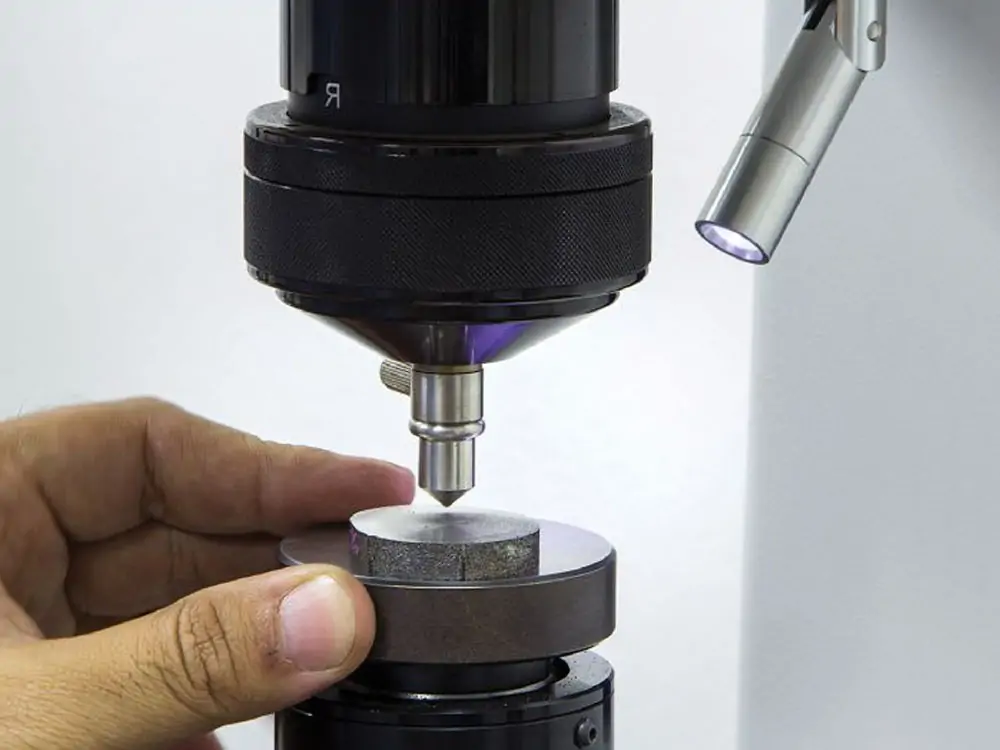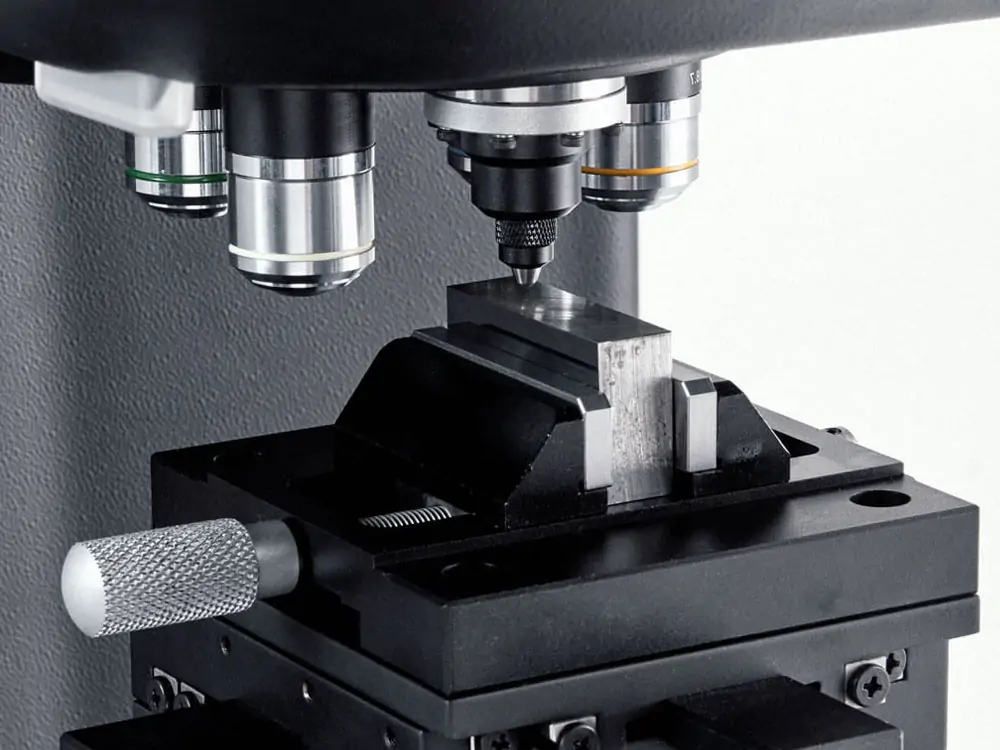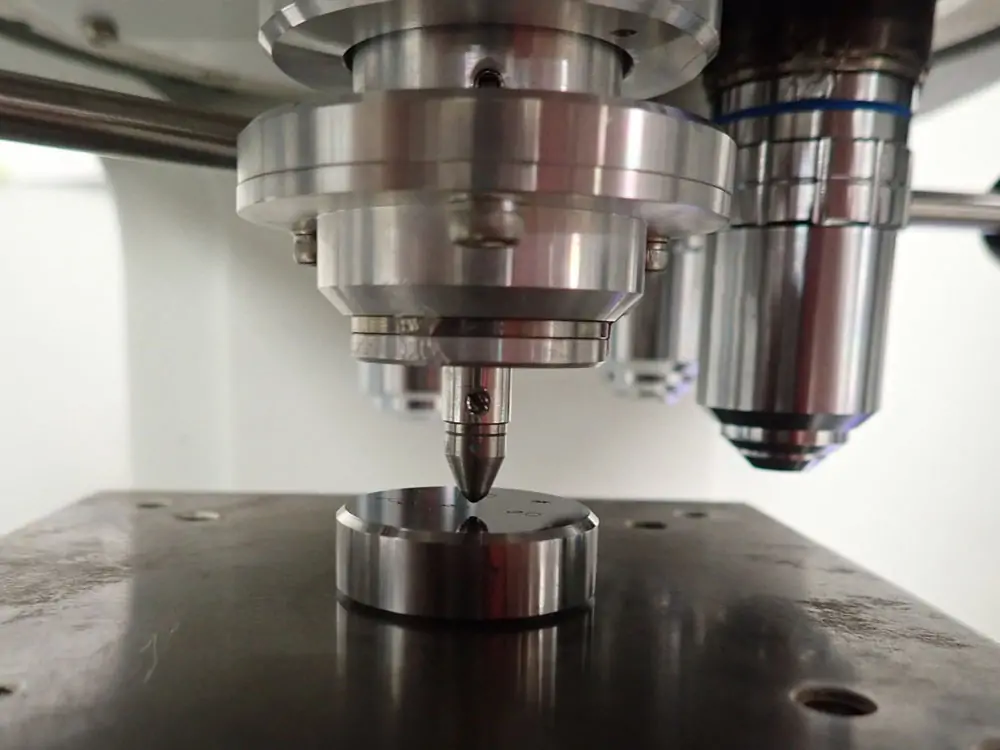The Rockwell hardness test and Vickers hardness test are two commonly and widely used techniques among the many hardness testing methods. They can test different types of materials. Rockwell and Vickers hardness tests adopt other principles and testing methods, respectively. They have their own unique advantages and applicable scenarios. This article aims to provide an in-depth look at these two hardness testing methods. We will compare their principles, benefits, limitations, and application areas. Readers can better understand these testing methods and make informed choices for appropriate applications.
This article will first introduce the working principles, advantages, and limitations of the Rockwell and Vickers hardness tests, respectively. Next, we will focus on the in-depth discussion of the differences between each testing method. In short, this article can provide readers with a comprehensive understanding and guidance.
Rockwell Hardness Test Introduction
Rockwell hardness testing is a commonly used hardness testing method for metal materials. It is based on the elastic and plastic deformation properties of materials under compression. This testing method mainly applies a specific load on the surface of the test material. After the load is released, the residual impression depth is measured to determine the material’s hardness value.
Working Principle
- Apply Load: First, press a tungsten carbon spherical steel ball or diamond gold conical tip into the material’s surface to be tested. Apply a particular load.
- Load Holding Phase: The load continues to be applied during the load-holding process. The test material undergoes elastic and plastic deformation, forming a residual impression.
- Unloading Phase: After maintaining the load for a certain period, reduce the load. Keep a small load to keep the residual impression stable.
- Measure The Depth of The Impression: Measure the depth of the remaining impression after the load is reduced to indicate the hardness value. There are usually different Rockwell hardness scales, such as Rockwell A, B, C, etc.
Advantages
- Fast And Easy: Rockwell hardness testing is quick and easy. It does not need a microscope or microscopic observation and is suitable for batch testing.
- Widely Applicable: Rockwell hardness testing can test various metallic and non-metallic materials. Including steel, aluminum, copper, plastic, ceramics, etc.
- Accurate And Reliable: The Rockwell hardness test provides repeatable hardness values. It has high precision and accuracy.
Limitation
- Surface Test Only: The Rockwell test can only measure the hardness of the material’s surface. It cannot provide information on the deep hardness of the material.
- Thickness Limitations: Material thickness and shape may affect test results. Especially for thinner or non-uniform materials.
- Sample Preparation: This needs proper sample preparation. It can ensure that the sample surface is flat and clean to ensure the accuracy of the test.
Applications
- Material Evaluation: It can check the hardness of materials. Such as metal alloys, steels, etc., to guide material selection and processing.
- Quality Control: It can control quality during the production process. It can ensure that manufactured parts meet hardness requirements.
- Engineering Design: It can determine material suitability and predict material performance during the engineering design phase.

Vickers Hardness Test Introduction
The Vickers hardness test is a commonly used hardness testing method for metals and hard materials. It is used to measure the hardness of materials. Vickers hardness testing uses the plastic deformation characteristics of materials under pressure to calculate hardness values. The following are the working principle, advantages, limitations, and applications of the Vickers hardness test.
Working Principle
- Apply Load: Use a diamond or carbide indenter with a specific shape (usually rhombus) to apply a particular load on the material’s surface to be tested. It is generally between a few grams to several kilograms.
- Maintain Load: The load is maintained for a certain period. The indenter will form a diamond-shaped indentation, causing plastic deformation of the material.
- Measure The Impression Size: measure the diagonal length of the impression (d1 and d2), and then calculate the hardness value. Usually the formula is used: H(V)=2P/(d1*d2)
Advantages
- Widely Applicable: Vickers hardness testing is suitable for various hard materials. These include metals, ceramics, glass, and graphite. It is also ideal for thin slices and small-sized samples.
- High Accuracy: It can provide high test accuracy and repeatability. It is especially suitable for measuring high-hardness materials.
- Unaffected By Material Size: Independent of material size, ideal for samples of different sizes and shapes.
Limitation
- High Surface Flatness Requirements: The surface of the material to be tested must be flat enough. It can ensure accurate impression size.
- Sample Size: Smaller samples may be limited by equipment size.
- Thickness: For thinner samples, the mark may penetrate the entire material, affecting the accuracy of the test results.
Applications
- Material Hardness Evaluation: It is used for hardness evaluation of various hard materials. Such as metals, ceramics, glass, and alloys. They can provide a reference for material selection and design.
- Quality Control: It can used for quality control during the manufacturing process. It can ensure products meet hardness standards and specifications.
- Research And Laboratory Applications: It can research laboratory settings for material characterization studies. It will help understand the hardness and properties of different materials.
- Metallurgical Research: It is used for metallic research. Compare the hardness of different materials and understand the impact of the material’s internal structure.

Rockwell vs Vickers Hardness Test
In the above content, we introduced the Rockwell and Vickers hardness tests in detail. If you still need clarification about the above, don’t worry. Let’s summarize and compare the differences below to help you better understand them.
Working Principle
- Rockwell Hardness Test: Hardness is calculated by applying a load to the surface of the test material and measuring the depth of the residual impression after the load is released.
- Vickers Hardness Test: A diamond-shaped diamond indenter is used to apply a load on the surface of the test material. Hardness is calculated by measuring the diagonal length of the diamond-shaped impression produced by the indenter.
Applicable Materials
- Rockwell Hardness Test: It is suitable for metal and non-metal materials. It is widely used in metal engineering materials.
- Vickers Hardness Test: It suits for hard materials, including metal, ceramics, glass, etc.
Load
- Rockwell Hardness Test: The load is large, usually between a few kilograms and several thousand kilograms.
- Vickers Hardness Test: The load is small, usually between a few grams and a few hundred grams.
Imprint Shape
- Rockwell Hardness Test: The impression produced is conical in shape.
- Vickers Hardness Test: The impression created is diamond-shaped.
Test Speed
- Rockwell Hardness Test: Relatively fast, suitable for quickly testing large batches of samples.
- Vickers Hardness Test: It is relatively slow. Because the diagonal length of the diamond-shaped impression needs to be measured.
Precision And Accuracy
- Rockwell Hardness Test: It provides high testing precision and accuracy. It is especially suitable for measuring high-hardness materials.
- Vickers Hardness Test: It also provides high precision and accuracy, especially for hard materials.
Application Scenarios
- Rockwell Hardness Test: It is widely used in manufacturing, metal engineering, quality control, and other fields. It is especially suitable for the hardness evaluation of metal materials.
- Vickers Hardness Test: It is mainly used to evaluate hard materials. It is especially suitable for materials research, ceramics, glass, and other fields.

Final Word
When we compare the Rockwell hardness test and the Vickers hardness test, we can see the characteristics and applicable scenarios of the two testing methods. Rockwell hardness testing is simple, fast, and widely practical for various materials. It has depth measurement and high repeatability. So, it is the preferred hardness testing method in many industrial sectors. In contrast, the Vickers hardness test stands out for its suitability for more brittle materials. It has high accuracy, and it can measure small specimens.
When selecting an appropriate hardness testing method, you should consider the material properties, testing requirements, and practical application. The Rockwell hardness test is suitable for general hardness measurement. At the same time, the Vickers hardness test is more suitable for testing that requires higher accuracy and small samples. Therefore, in actual engineering and scientific research, we can choose the most suitable hardness testing method according to specific needs. Ensure accurate hardness values and reliable material performance evaluation. It can provide strong support for engineering design and material selection.